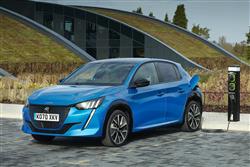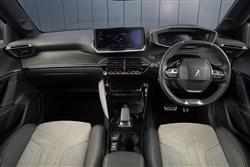ELECTRIC DREAMS (some text hidden) --NONE--
By Jonathan Crouch
Introductionword count: 60
It's getting harder and harder to resist the draw of full-electric vehicles. Most of them seem to be SUVs these days but here's a Zero Emission supermini, the Peugeot e-208, which was introduced in 2019. It looks snappy, in its original form did 211 miles between charges and has no practicality downsides over the combustion-engined version. What's not to like?
Modelsword count: 8
5dr supermini (EV) [Active, Allure, GT Line, GT]
Historyword count: 173
In the future, all small cars will need to be developed on platforms that can support full-electric as well as conventional thermic propulsion. Back in 2019, few were but the MK2 Peugeot 208 was an exception. From new, the brand wanted you to pick a powertrain for this model (petrol, diesel or electric) in the same way you'd select a trim option - and it's the battery-powered variant, the e-208, that we look at here. It shared all the same engineering that back in 2019 we'd already also seen in the Stellantis Group's two other small car battery-powered products, the Vauxhall Corsa-e and the DS 3 Crossback E-TENSE, a pair of designs that shared this Peugeot's sophisticated CMP ('Common Modular Platform'). And those same underpinnings allowed for a new generation of 'big car'-style camera safety systems. The MK2 e-208 sold in its original form until mid-2023, when it was significantly facelifted and given a perkier electric motor and a slightly larger 51kWh battery. It's the pre-facelift version though, that we look at here.
What You Getword count: 285
The all-electric e-208 was distinguished from what Peugeot calls 'thermic'-powered models by the adoption of body colouring for the front grille and a more unusual 'Dichroic' finish for the lion badge that appears to change colour, depending on your viewing angle. Most versions of this model were ordered in either 'GT-Line' or top 'GT'-spec, these two top variants recognisable by 'diamond black' roof colouring and glossy black wheel arch flares, which streamline the body, making the wheel diameter of the 17-inch wheel rims appear larger. Inside, there's the usual 208 'i-Cockpit' driving position format that sees you viewing the instrument binnacle over the upper rim of a tiny steering wheel rather than conventionally through the wheel spokes. On all but the entry-level version of this model, you'll find that the concept was further developed with the addition of a clever 3D instrument binnacle display. More media technology sits to your left in the form of the usual centre-dash touchscreen, normally 7.0-inches in size but offered on top models in 10-inch form. The seats are reasonably comfortable, there's not much wrong with the ergonomics and there's a reasonable amount of cabin storage space. What about the rear? Well it's certainly more cramped than the supermini norm but it'll be fine for the children who'll most commonly travel back here. The curvature of the front seat backs is designed to improve knee room, there's a notably low centre transmission tunnel and there's lots of room to poke your feet beneath those front chairs. There's no compromise in boot space, which is 311-litres in size just like any other 208. It's quite a usable, squarically-sized space, with 674mm of length and 1,018mm of width between the wheel arches.
To see the full road test text contact us on 0330 0020 227
Pictures (high res disabled)
.jpg)
.jpg)
|
.jpg)
|
.jpg)
| |||
.jpg)
|
.jpg)
|

| |||
.jpg)
|
.jpg)
|
.jpg)
| |||

|
Scoring (subset of scores)
Category: Hybrid, Plug-in, Electric & Hydrogen
| Performance | |
| Handling | |
| Comfort | |
| Space | |
| Styling, Build, Value, Equipment, Depreciation, Handling, Insurance and Total scores are available with our full data feed. | |



